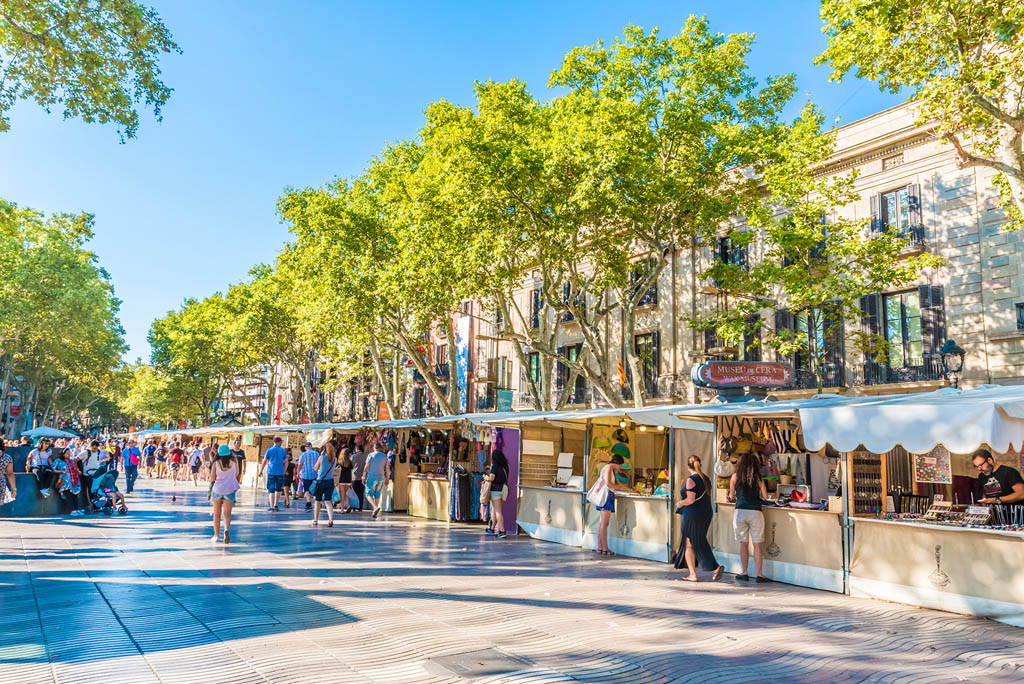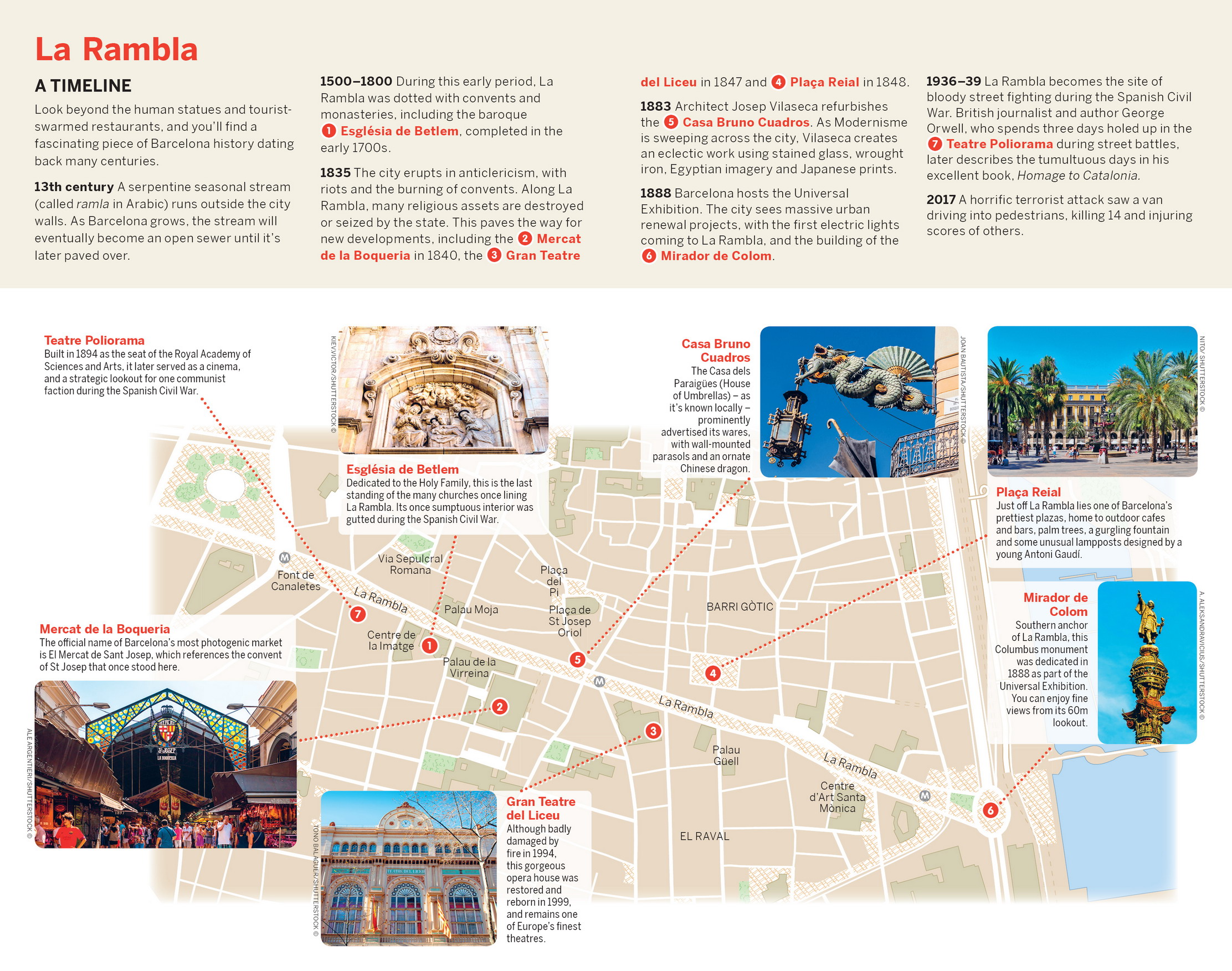TOP SIGHT
LA RAMBLA
Barcelona’s most famous street is both a tourist magnet and a window into Catalan culture, with cultural centres, theatres and intriguing architecture. The middle of La Rambla is a broad pedestrian boulevard – a stroll here is pure sensory overload, with souvenir hawkers, buskers, pavement artists, mimes and living statues all part of the ever-changing street scene.

History
La Rambla takes its name from a seasonal stream (ramla in Arabic) that once ran here. From the early Middle Ages, it was better known as the Cagalell (Stream of Shit) and lay outside the city walls until the 14th century. Monastic buildings were then built and, subsequently, mansions of the well-to-do from the 16th to the early 19th centuries. Unofficially La Rambla is divided into five sections, which explains why many know it as Las Ramblas.
La Rambla de Canaletes
The section of La Rambla north of Plaça de Catalunya is named after the Font de Canaletes, an inconspicuous turn-of-the-20th-century drinking fountain, the water of which supposedly emerges from what were once known as the springs of Canaletes. It used to be said that a proper barcelonin was one who ‘drank the waters of Les Canaletes’. Nowadays people claim that anyone who drinks from the fountain will return to Barcelona, which is not such a bad prospect. Delirious football fans gather here to celebrate whenever the main home side, FC Barcelona, wins a cup or the league premiership.
La Rambla dels Estudis
La Rambla dels Estudis, from Carrer de la Canuda running south to Carrer de la Portaferrissa, was formerly home to a twittering bird market, which closed in 2010 after 150 years in operation. Just north of Carrer del Carme, the Església de Betlem (![]() %93 318 38 23; www.mdbetlem.net; Carrer d’en Xuclà 2;
%93 318 38 23; www.mdbetlem.net; Carrer d’en Xuclà 2; ![]() h8.30am-1.30pm & 6-9pm;
h8.30am-1.30pm & 6-9pm; ![]() mLiceu) was constructed in baroque style for the Jesuits in the late 17th and early 18th centuries to replace an earlier church destroyed by fire in 1671. Fire was a bit of a theme for this site: the church was once considered the most splendid of Barcelona’s few baroque offerings, but leftist arsonists torched it in 1936.
mLiceu) was constructed in baroque style for the Jesuits in the late 17th and early 18th centuries to replace an earlier church destroyed by fire in 1671. Fire was a bit of a theme for this site: the church was once considered the most splendid of Barcelona’s few baroque offerings, but leftist arsonists torched it in 1936.
Looming over the eastern side of La Rambla, Palau Moja (![]() %93 316 27 40; https://palaumoja.com; Carrer de Portaferrissa 1;
%93 316 27 40; https://palaumoja.com; Carrer de Portaferrissa 1; ![]() h10am-9pm, cafe 9.30am-midnight Mon-Fri, 11am-midnight Sat & Sun;
h10am-9pm, cafe 9.30am-midnight Mon-Fri, 11am-midnight Sat & Sun; ![]() mLiceu)
mLiceu) ![]() F is a neoclassical building dating from the second half of the 18th century. Its clean, classical lines are best appreciated from across the other side of the street. It mostly houses government offices, but access is now an option thanks to a large gift shop and cafe.
F is a neoclassical building dating from the second half of the 18th century. Its clean, classical lines are best appreciated from across the other side of the street. It mostly houses government offices, but access is now an option thanks to a large gift shop and cafe.
La Rambla de Sant Josep
From Carrer de la Portaferrissa to Plaça de la Boqueria, what is officially called La Rambla de Sant Josep is lined with flower stalls, which give it the alternative name La Rambla de les Flors. This stretch also contains the bawdy Museu de l’Eròtica (Erotica Museum; MAP; ![]() %93 318 98 65; www.erotica-museum.com; €10;
%93 318 98 65; www.erotica-museum.com; €10; ![]() h10am-midnight;
h10am-midnight; ![]() mLiceu).
mLiceu).
The Palau de la Virreina is a grand 18th-century rococo mansion (with some neoclassical elements) that now houses the Centre de la Imatge (![]() %93 316 10 00; www.ajuntament.barcelona.cat/lavirreina; Palau de la Virreina;
%93 316 10 00; www.ajuntament.barcelona.cat/lavirreina; Palau de la Virreina; ![]() hnoon-8pm Tue-Sun;
hnoon-8pm Tue-Sun; ![]() mLiceu)
mLiceu) ![]() F, which has rotating photography exhibits.
F, which has rotating photography exhibits.
Just south of the Palau, in El Raval, is the Mercat de la Boqueria, one of the best-stocked and most colourful produce markets in Europe. At Plaça de la Boqueria, just north of Liceu metro station, you can walk all over a Miró – the colourful mosaic in the pavement, with one tile signed by the artist.
La Rambla dels Caputxins
La Rambla dels Caputxins, named after a former monastery, runs from Plaça de la Boqueria to Carrer dels Escudellers. On the western side of La Rambla is the Gran Teatre del Liceu ; to the southeast is the entrance to the palm-shaded Plaça Reial.
La Rambla de Santa Mònica
The final stretch of La Rambla widens out to approach the Mirador de Colom overlooking Port Vell. La Rambla here is named after the Convent de Santa Mònica, which once stood on the western flank of the street and has since been converted into the Centre d’Art Santa Mònica, a cultural centre that mostly exhibits modern multimedia installations.
